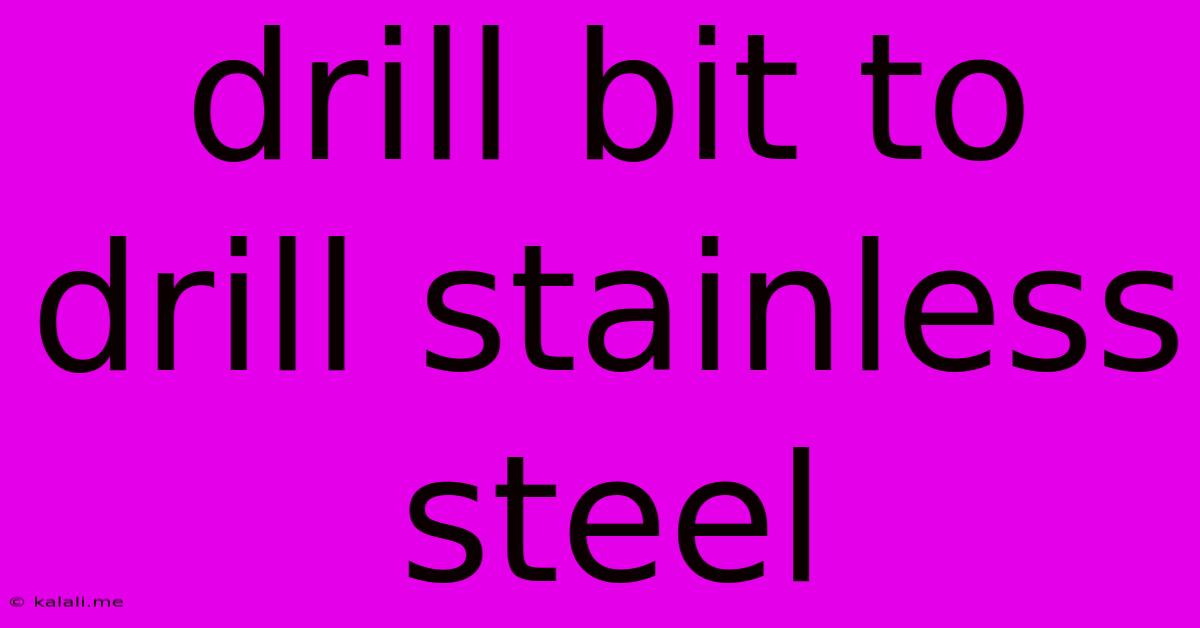Drill Bit To Drill Stainless Steel
Kalali
Jun 01, 2025 · 3 min read

Table of Contents
The Best Drill Bits for Stainless Steel: A Comprehensive Guide
Drilling stainless steel can be challenging, even for experienced DIYers. Its high tensile strength and work-hardening properties mean standard high-speed steel (HSS) bits will quickly dull or break. This guide will explore the types of drill bits best suited for piercing this tough metal, offering tips and tricks for a successful drilling experience. We'll cover everything from bit selection to crucial techniques, ensuring you achieve clean, accurate holes every time.
Understanding the Challenges of Drilling Stainless Steel
Stainless steel's unique properties pose several challenges during drilling:
- High Tensile Strength: This makes it difficult to penetrate the material without significant force, leading to bit breakage.
- Work Hardening: As the bit cuts, the metal around the hole becomes harder, further increasing resistance and wear on the bit.
- Heat Generation: Friction generates significant heat, which can dull the bit rapidly and potentially damage the workpiece.
Types of Drill Bits Ideal for Stainless Steel
Several specialized drill bits are designed to overcome these challenges:
-
Cobalt Drill Bits: These are the most common choice for drilling stainless steel. The addition of cobalt to the HSS alloy significantly increases the bit's hardness and heat resistance, allowing for cleaner cuts and a longer lifespan. Look for bits with a cobalt content of at least 5%. Cobalt steel drill bits are a superior choice for repeated drilling tasks.
-
Titanium Nitride (TiN) Coated Drill Bits: A TiN coating adds a layer of hardness and reduces friction, resulting in less heat generation and improved wear resistance. This type of drill bit is generally more affordable than cobalt bits, offering a good balance of performance and cost.
-
Carbide Drill Bits: For very hard stainless steel grades or larger diameter holes, carbide bits are the best option. They offer exceptional hardness and durability but are significantly more expensive.
-
High-Speed Steel (HSS) Drill Bits with a Split Point: These bits have a specialized point design that helps center the bit and reduce the initial cutting force, minimizing the chances of the bit wandering or breaking. While not as effective as cobalt or carbide, they are useful for smaller drilling projects.
Choosing the Right Drill Bit: Key Considerations
Selecting the appropriate drill bit depends on several factors:
- Stainless Steel Grade: Different grades of stainless steel have varying hardness and machinability. Harder grades will require a more robust drill bit.
- Hole Diameter: Larger holes require more robust bits capable of withstanding greater forces.
- Drilling Frequency: For frequent drilling, invest in higher quality, longer-lasting bits like cobalt steel.
Drilling Techniques for Stainless Steel
Optimizing your drilling technique is as important as choosing the right bit:
- Use Cutting Fluid/Lubricant: Applying a cutting fluid (like cutting oil or even plain water) helps to reduce friction, heat, and wear on the bit and workpiece. Keep the lubricant flowing consistently while drilling.
- Low Speed, High Pressure: Drill at a slower speed with consistent, firm pressure to prevent the bit from overheating and dulling quickly.
- Pilot Holes: For larger diameter holes, drill a smaller pilot hole first to guide the larger bit and reduce the likelihood of breakage.
- Sharp Bits Only: Using a dull bit will lead to frustration and likely damage your workpiece. Replace dull bits immediately.
- Proper Clamping: Ensure the stainless steel is securely clamped to prevent movement during drilling.
Conclusion
Drilling stainless steel successfully requires careful bit selection and proper technique. By understanding the challenges and choosing the right tools, you can achieve clean, accurate holes every time. Remember to prioritize safety and always wear appropriate safety gear like eye protection and gloves. With the right approach and a little patience, your next stainless steel drilling project will be a success!
Latest Posts
Latest Posts
-
When Should I Replace My Spark Plugs
Jun 03, 2025
-
Accidentally Left Hose On All Night Well
Jun 03, 2025
-
What Oil To Use In My Car
Jun 03, 2025
-
How Can Diagonals Be Congruent In Coordinate
Jun 03, 2025
-
What Are The Seven Kingdoms In The Game Of Thrones
Jun 03, 2025
Related Post
Thank you for visiting our website which covers about Drill Bit To Drill Stainless Steel . We hope the information provided has been useful to you. Feel free to contact us if you have any questions or need further assistance. See you next time and don't miss to bookmark.